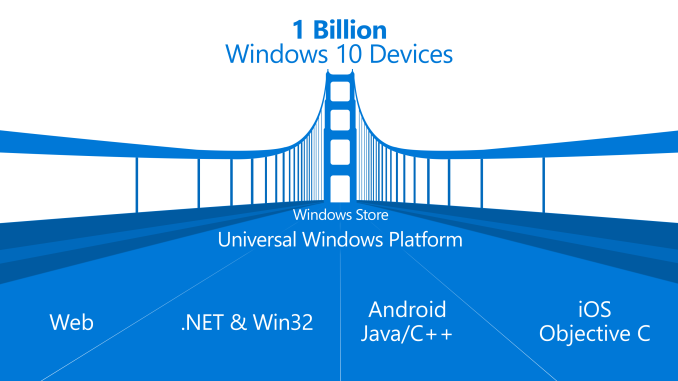Microsoft Ends Effort To Bring Android Apps To Windows 10 Mobile
by Brandon Chester on February 25, 2016 4:50 PM EST- Posted in
- Smartphones
- Microsoft
- Windows 10 Mobile

At the 2015 BUILD developer Conference Microsoft demoed four application bridges that they hoped would improve the number of applications available for Windows 10 Mobile, which would benefit the Windows platform as a whole. The two most interesting showcases were Project Islandwood, which helps developers to port their Objective-C applications to Windows, and Project Astoria, a subsystem for running existing Android applications right on a Windows smartphone. Today it looks like the latter of those projects has officially met its end.
The death of Project Astoria won't come as a big surprise to those who have been keeping track of Windows 10 Mobile's development process since BUILD. Back in October of last year, preview builds of Windows 10 Mobile stopped including the Android runtime and there wasn't really any explanation as to why. Since that time, Project Islandwood has continued to be promoted by Microsoft while there hasn't been much news about Astoria. This led many in the development community to suspect that Microsoft had decided to kill the project, although there was no official confirmation until today.
In my view, the death of Project Astoria has both good and bad elements. Since it was essentially packaging Android applications to run on Windows 10 Mobile, the applications never fit in with the rest of the platform and so the question then became why you wouldn't just go buy an actual Android device. On the other hand, it did provide an easy way for developers and users to bundle up applications that didn't exist at all on Windows 10 Mobile, which would help fill the app gap in a less than optimal but usable manner.
According to Microsoft, the official reason for the death of Astoria is that developers felt that having two bridges from mobile operating systems was mostly redundant when their applications likely existed on both Android and iOS. With Microsoft's recent purchase of Xamarin, they may also be betting on developers creating applications in C# that can be deployed across Android, Windows, and iOS. In any case, Microsoft's bridges for Objective-C, JavaScript, and Win32 apps are still very much alive, but the prospect of easily bringing over Android applications to Windows 10 Mobile is gone.
Source: Microsoft Windows Blog










45 Comments
View All Comments
boozed - Friday, February 26, 2016 - link
Microsoft's continuing missteps in the mobile arena really are quite entertaining!marvdmartian - Monday, February 29, 2016 - link
"...the question then became why you wouldn't just go buy an actual Android device"??And that pretty much sums it all up, doesn't it? Frankly, I'm a bit tired of this new MS CEO's attitude, concerning Windows 10, of "Take it or leave it, we don't care". Fine, neither do I, and since I've now taken the time to reassess my computing needs that require Windows operating system, I'm finding out that they are few and far between.
Since MS obviously doesn't give a crap about the little guys, I'm more than happy to make the jump to another OS. If MS is going to act like Apple during the Steve Jobs era, so be it.
BrokenCrayons - Monday, February 29, 2016 - link
Microsoft in years past has exhibited the attitude you mention. I think that's more an indicator of the company's position of market dominance influencing executive management decisions than something specific to the current CEO. However, I also agree that there are viable options outside the Microsoft ecosystem that can fulfill most day-to-day computing needs as long as one is willing to accept a different set of platform limitations.The lack of data collection transparency from Microsoft that seemed to begin during the Windows 8.1 to 10 transition was enough to push me into taking a long, hard look at what I do with a computer and figure out that any of the more popular Linux distros would address every categorical computing need I could identify. Having dabbled in various *nix operating environments since the late 1990s, the transition for me was an easy one. The only thing I gave up were a few games that I didn't care bring over because I don't want to add WINE, but those are the lowest priority items on my list and there's lots of other entertainment available in native binaries.
To get back to the article though, I think what we're seeing is part of Microsoft's surrender of the mobile market to Apple and Android. They're still failing to capture more than the smallest fraction of handset sales so investing in development platforms isn't good for the balance sheets. Unless something dramatic happens in the mobile market over the next year or two, I expect to see Windows 10 Mobile to go to the same graveyard in which earlier PDA-based Windows Mobile is buried.
Agnes Philomena - Thursday, March 3, 2016 - link
Can this stack UDR code from Reject 5.1 without the Sys Admin zombies wailing about backdoor locks?I mean, common. After our lab monks plugged BitJam's proprietary "device" they just laughed at the hysteresis. 15 micros is enough.
XmppTextingBloodsport - Saturday, March 19, 2016 - link
Ignore the elephant-gorilla hybrid in the room: malware masquerading as free.ALL adware is malware.